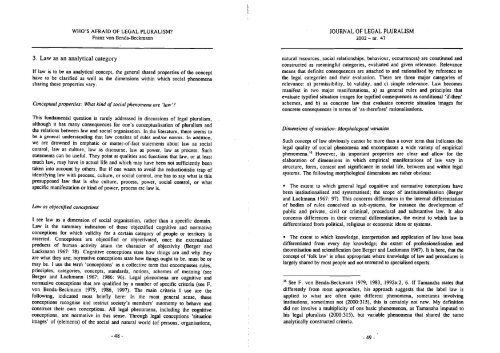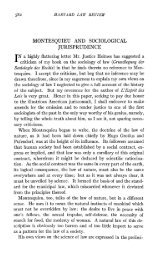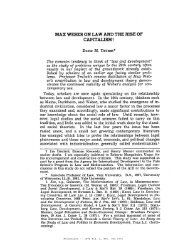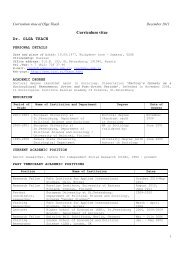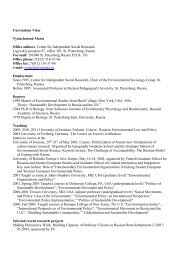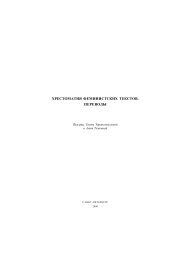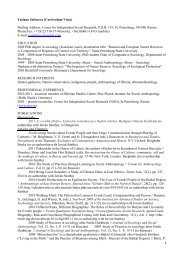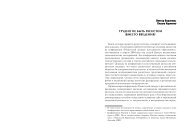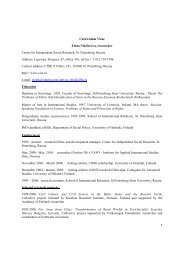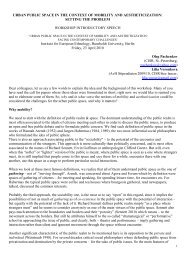who's afraid of legal pluralism?
who's afraid of legal pluralism?
who's afraid of legal pluralism?
You also want an ePaper? Increase the reach of your titles
YUMPU automatically turns print PDFs into web optimized ePapers that Google loves.
WHO'S AFRAID OF LEGAL PLURALlSM?Franz von Benda-BeckmannJOURNAL OF LEGAL PLURALISM2002 - nr. 473. Law as an analytical categoryIf law is to be an analytical concepl, the general shared properties <strong>of</strong> the concepthave lO be ciarified as well as the dimensions within which social phenomenasharing these properlies vary.Conceptual properties: What kind 01 social phenomena are 'law'?This fundamental question is rarely addressed in discussions <strong>of</strong> <strong>legal</strong> <strong>pluralism</strong>,although il has many consequences for one's conceplualisalion <strong>of</strong> <strong>pluralism</strong> andthe relalions belween law and social organisation. In the Iiterature, there seems tobe a general understanding thal law consists <strong>of</strong> rules and/or norms. In adc!ition,we are drowned in emphalic or malter-<strong>of</strong>-fact SlalemenlS aboul law as socialcontrol, law as culture, law as discourse, law as power, law as process. Suchslalemenls can be usefuI. They poinl al qualities and functions thal law, or al leaslmuch law, may have in actual life and Which may have been nol sufficiently been~ake~ i~IO accoun.l by olhers. But if one wants to avoid the reductionistic trap <strong>of</strong>Identlfymg law wuh process, culture, or social control, one has to say what is thispresupposed law that is also culture, process, power, social control, or whatspecific manifestation·or kind <strong>of</strong> power, process etc law ¡s.l.Aw as objectijied conceptionsI see law as a dimension <strong>of</strong> social organisation, rather lhan a specific domain.Law is lhe summary indication <strong>of</strong> those objeclified cognitive and normaliveconceptions for which validity for a certain calegory <strong>of</strong> people or territory isasserted. Conceplions are objectified or objeclivated, once lhe externalisedproducls <strong>of</strong> human activily anain the character <strong>of</strong> objeclivity (Berger andLuckmann 1967: 78). Cognitive conceptions state how things are and why theyare whal they are; nqrmative conceplions slate how things ought to be, must be orm~y ~e. I use Ihe term 'conceptions' as a colleClive lerm lhal.encompasses rules,pnnclples. categories, concepls, standards, nolions, schemes <strong>of</strong> meaning (seeBerger and Luckmann 1967; 1986: 96). Legal phenomena are cognitive andnormative conceptions Ihat are qualified by a number <strong>of</strong> specific criteria (see F.von Benda-Beckmann 1979, 1986, 1997). The main criteria I use are thefollowing, indicated most briefly here: In the mosl general sense, theseconceplions recognise and reslricl society's members' autonomy to behave andconstru~t lheir own conceptions. AII <strong>legal</strong> phenomena, including the cognitive~oncep~lOns, are normative in t~is sense. Through <strong>legal</strong> conceptions 'situationtmages <strong>of</strong> (elements) <strong>of</strong> lhe social and natural world (<strong>of</strong> persons, organisations.- 48 natural resources, social relationships, behaviour, occurrences) are constituted andconstrucled as meaningful categories, evalualed and given relevance. Relevancemeans lhat definite consequences are altached to and rationalised by reference tothe <strong>legal</strong> categories and their evaluation. There are three major categories <strong>of</strong>relevance: a) permissibility, b) validity, and c) simple relevance. Law becomesmanifest in two major manifestations, a) as general rules and principies thatevaluale typified situation images for lypified consequences as conditional 'if-then'schemes, and b) as concrele law that evaluates concrele .situation images forconcrete conseq~ences in terms <strong>of</strong> 'as-therefore' rationalisations.Dimensions 01 variation: Morphological variationSuch concepl <strong>of</strong> law obviously cannol be more than a cover term that indicates the<strong>legal</strong> quality <strong>of</strong> social phenomena and encompasses a wide variety <strong>of</strong> empiricalphenomena. 16 However, its important properties are clear and allow for theelaboration <strong>of</strong> dimensions in which empirical manifestalions <strong>of</strong> law vary instructure, form, content and significance in social life, belween and within <strong>legal</strong>systems. The following morphological dimensions are ralher obvious:• The extent to which general <strong>legal</strong> cognitive and normative conceptions havebeen instilutionalised and systematised; the scope <strong>of</strong> institutionalisation (Bergerand Luckmann 1967: 97). This concerns differences in the internal differentiation<strong>of</strong> bodies <strong>of</strong> rules conceived as sub-systems, for inslance the development <strong>of</strong>public and private, civil or criminal, procedural and subslantive law. It alsoconcerns differences in their external differentiation, the extent to which law isdifferentiated from political, religious or economic ideas or systems.• The extem lo which knowledge, interpretation and application <strong>of</strong> law have beendifferentiated from every day knowledge; the extent <strong>of</strong> pr<strong>of</strong>essionalisation andtheoretisation and sdemification (see Berger and Luckmann 1967). lt is here, that theconcepl <strong>of</strong> 'folk law' is <strong>of</strong>ien appropriate where knowledge <strong>of</strong> law and procedures islargely shared by most people and not entrusted lO specialised experts.16 See F. von Benda-Beckmann 1979, 1983, 1992a:2, 6. If Tamanaha states thatdifferemly from mosl approaches, his approach suggests that the label law isapplied to whal are <strong>of</strong>ten quile differem phenomena, sometimes involvinginstitulÍons. somelÍmes not (2000:315), this is certainly nol new. My definitiondid not involve a mulliplicity <strong>of</strong> one basic phenomenon, as Tamanaha imputed tohis <strong>legal</strong> pluralists (2000:315), but variable phenomena tha! shared the sameanalytically constructed crileria.- 49


